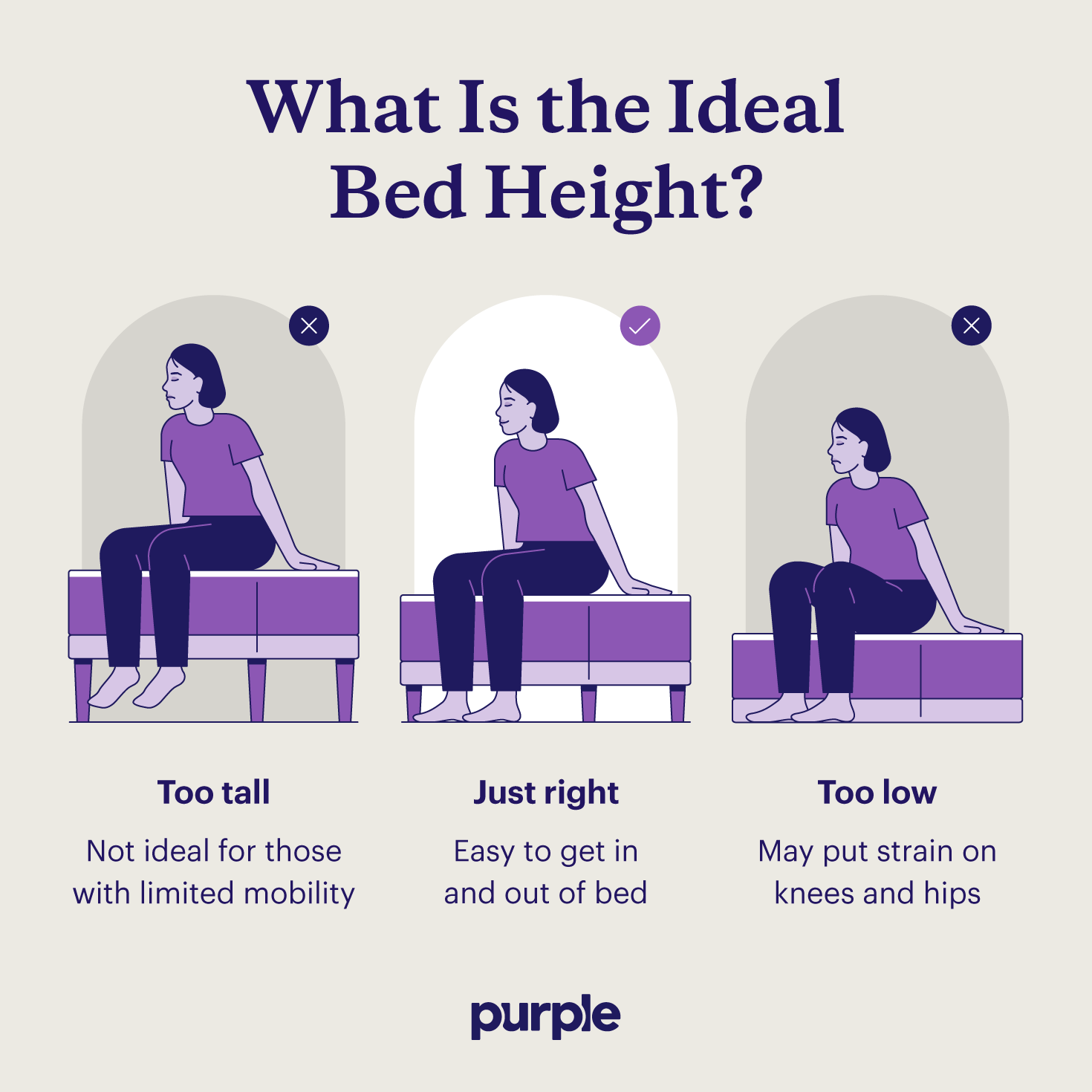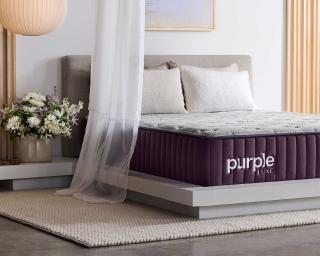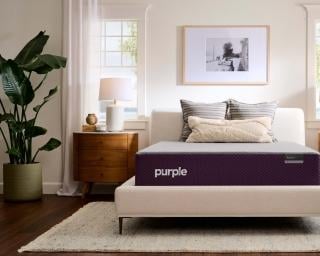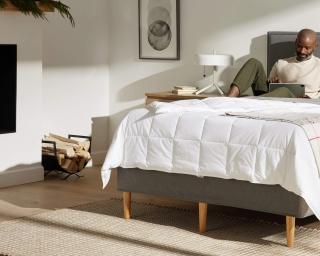
Does Bed Height Matter? How To Choose Your Ideal Bed Height
Key Takeaways
- Most standard bed heights range from 18 to 25 inches tall, depending on your bed frame, base, and mattress.
- The height of your bed can affect how easily you climb into and out of bed, so finding the right bed height can make a big difference in your overall comfort.
- To find your ideal bed height, consider your height, age, mobility, partner, mattress thickness, room size, and comfort preferences.
Bed height may not be something you automatically think about when picking out a bed frame and mattress that best suits your needs and preferences. But your bed's height can make a huge difference in your sleeping experience.
Bed height can affect how comfortable you are getting in and out of bed as well as influence the overall look of your bedroom. Make sure you choose a bed frame for the correct mattress size that not only provides essential support for your mattress but also raises it to a comfortable height to improve your sleep experience.
If you’re not sure how tall your bed should be, this guide will tell you how to measure bed height, why bed height matters, and what you should consider to determine your ideal bed height.
How To Measure Bed Height
Measuring the height of your bed is easy enough when you have everything assembled — simply measure the mattress height from the floor while it’s resting on a foundation, base, or bed frame. In other words, use a tape measure from the floor to the top of your mattress.
If you’re pairing a box spring or flat foundation with a bed frame, follow these steps to measure bed height:
- Measure from the floor to the cross-slat bar of the bed frame.
- Measure the height of the flat foundation.
- Measure the height of the mattress.
- Add the total heights of the bed frame, flat foundation, and mattress to get the total bed height.
Many bed frames have side panels that extend past the cross-slat bar, allowing a flat foundation or box spring to sit within the frame. When calculating bed height, it’s important to avoid measuring the total height of the side panels.
Why Does Bed Height Matter?
Mattress and bed height directly impact how easy it is to climb in and out of bed. When buying a bed base or foundation, many people don’t consider the height of their mattress. This usually results in a sleeping setup that’s either too high or too low.
Complete bed height (the total elevation of your mattress and bed frame) matters because it impacts the overall sleeping experience in a few ways beyond just comfort, including:
Mobility
Getting in and out of your bed puts a fair bit of pressure on your legs and hips, especially if it’s lower or higher than it needs to be.
Getting up from a mattress that’s too low requires more effort, which may be physically taxing for individuals with conditions like knee problems, joint pain, or IT band pain. Conversely, you can’t comfortably climb into too-high beds. Even younger individuals with no nagging aches and pains may struggle with a high loft.
Storage
Generally, tall beds offer more under-bed storage than low-profile beds. Beds that are higher off the ground typically provide more open space to store your belongings. Some types of bed frames also have built-in storage.
Room Aesthetic
Bed height also impacts how your room looks. Some people prefer the luxurious image of a high bed, while others like the spartan setup of a mattress on the floor.
When taking room aesthetics into account, other considerations may include:
- How much furniture you plan on decorating your room with
- How tall your nightstand is compared to your bed frame
- How high or low your ceilings are
- What your overall aesthetic will be
You should aim for a bed frame that is four or fewer inches taller than the top of your nightstand for accessibility so you can easily reach items like a lamp, alarm clock, or phone.
What Is the Best Height for a Bed?
The ideal bed height will depend on several factors, including your age, height, and mobility. That said, the average height for a bed is around 24 inches, including your mattress. This applies to all bed sizes, from twin to California king. This standard height for beds also adheres to the global average knee height, which is between 16 and 24 inches.
How To Find the Best Bed Height for You
Building the perfect bed setup can be an arduous process. From selecting the right mattress size to picking the appropriate bed foundation, things can feel overwhelming very quickly. With an already long list of considerations, many people forget that mattress and bed height is just as important as any other factor.
You can find the right bed height for you by sitting on the edge of your mattress with your legs hanging over it. Your legs should be close to a 90-degree angle. It can be slightly more or less, but this is what you should aim for.
Here are additional factors to consider when deciding the right bed height for you:
- Your height
- Your age and mobility
- Who you share a bed with
- Your mattress support and bed frame
- Room size
- Personal preferences
1. Account for Your Height
Ideal bed frames should align with your knee height, which varies from person to person. An easy way to measure this is to stand at the side of the bed and observe whether the top of the mattress aligns with your knees. If you want more accurate results, simply take a tape measure from the bottom of your feet to the top of your knee.
You can test for the right bed height by sitting at the edge of the mattress, placing your feet flat on the floor, and checking whether your lap is level with your hips.
2. Think About Your Age and Mobility
Younger children will benefit from lower beds because they are easy to climb in and out of. Plus, there is less risk of a far drop if they fall out of bed.
As you get older and potentially develop hip pain, joint pain, and other mobility issues, purchasing a bed with an appropriate height will make a world of a difference. Seniors may develop long-term problems from using low beds that require crouching or tall beds that require jumping or lifting.
3. Accommodate Your Partner
Choosing the best bed size for couples requires consideration of both individuals’ needs and preferences, and deciding on the best bed height is no different.
If you share a bed with someone who isn’t the same height as you, picking the appropriate bed frame can be challenging. Always consider both of your individual needs. If one of you has joint problems or back pain, consider adjusting more to that person’s requirements.
Alternatively, you can purchase a bed step to make it easier for a shorter partner to get in and out of bed.
4. Provide Mattress Support
The thickness of your mattress will influence what type of bed frame you need. Most mattresses are between 8 and 14 inches thick, with standard thicknesses between 10 and 12 inches. If you have a bed frame that is 16 inches tall and you want a total height of 25 inches, you should purchase a mattress roughly 9 inches thick.
5. Consider the Size of Your Room
Deciding on a suitable bed height may be less challenging than determining what size bed you should get, but different bed heights can affect the look and functionality of your room. While mattresses and bed frames of the same size will take up roughly the same amount of floor space, the height of your bed can impact the look and feel of your bedroom.
In a room with a low ceiling, a taller bed may make the space feel more cramped than it actually is. For rooms with high ceilings, low-profile beds may not fill the space as well as a tall bed would.
6. Match Your Comfort Preferences
While most look at mattress types to achieve optimal comfort levels, bed height can also make a difference. A perfectly raised bed should make getting in and out effortless, which can improve the experience of going to sleep and waking up in the morning.
Heights of Different Types Of Platforms And Beds
Different bed frames and platform styles tend to have varying height ranges, affecting how tall your bed is. Not sure what size bed to get? Check out our bed frame sizes guide.
Below are six primary types of bed frames, their average heights, and who should consider them.
Platform
Average height: 9 to 14 inches
Ideal for: Shorter or average-size people who want simple, solid support with storage space
Without the need for another base or box spring, platform beds offer simple support for your mattress. They have solid or slatted surfaces and sit lower to the ground than a standard bed frame.
A platform bed is most appropriate for low-ceiling rooms, lofts, or minimal setups. But, while they provide additional space, they may not be the best choice for taller or elderly sleepers.
Adjustable Base
Average height: 5 to 14 inches
Ideal for: Sleepers who want to customize their sleep position
Adjustable bed heights vary greatly depending on the kinds of features you need. As their name suggests, they allow you to adjust your bed’s positioning to achieve optimal comfort. However, you can’t use this feature to change your bed’s height.
Adjustable bed bases work with various mattresses, depending on type. For example, GelFlex Grid®, hybrid, polyfoam, and memory foam mattresses are especially good options.
Flat Foundation
Average height: 5 to 9 inches
Ideal for: People who want extra support or want to raise their mattress higher than a bed frame alone
Like box springs, flat foundations provide added height and support for mattresses. Flat foundations have a different construction than box springs, resulting in a more durable base that provides firm, even support.
Flat foundations are typically available in two sizes. Standard foundations measure 9 inches tall while low-profile options tend to measure 5 inches in height.
While flat foundations tend to have a higher price tag, they may last longer and provide better support for a range of mattress types. Box springs are primarily designed to support innerspring mattresses, whereas flat foundations can support any mattress type, including GelFlex Grid®, memory foam, and latex.
Traditional
Average height: 25 inches
Ideal for: Sleepers who want a more traditional look
Most standard bed frames have wooden or metal slats and require either box springs or foundations measuring up to nine inches on their own.
If you decide to use a box spring, you’ll have to pair it with an innerspring mattress, which may not provide the most supportive, durable, and comfortable sleep experience.
Upholstered Frame
Average height: 14 to 17 inches
Ideal for: Sleepers who have specific aesthetic preferences
Upholstered beds are similar to standard frames but incorporate additional materials like suede, velvet, or faux leather. Most upholstered frames sit lower to the ground, though some options can sustain an additional layer for extra height.
Antique
Average height: 36 inches
Ideal for: Taller people who want extra storage
Antique bed frames are often taller than modern bed frames. These beds are typically made of wood, have posts in each corner, and have ample space underneath for storage, though their exact look and construction may vary based on bed style. Due to their height, they may not be appropriate for petite sleepers, kids, and older people.
What Bed Height Is Right for You? Pros and Cons of High vs. Low Beds
Pros | Cons | |
High beds |
|
|
Low beds |
|
|
Overall, the average bed height is between 18 and 25 inches. Depending on your specific needs and body type, you may take better to a higher or lower bed.
For instance, if you are older and have trouble getting in and out of bed, you might consider a bed that sits low. On the other hand, if you want additional storage and are very agile, a high bed might suit you better.
Aesthetics might also play a role in your decision-making process. For example, lower beds create a lot more open space, while high beds might complement a room with a high ceiling.
Why Some Mattresses Are Taller Than Others
Different mattresses contain base and comfort layers of varying thicknesses, which is why some beds are taller than others. The base layer is the foundation for the entire bed and provides rigidity and structure.
Meanwhile, the comfort layer is made of sheets of foam, gel, and or plush material. Thicker comfort layers usually result in more plush sleeping experiences, while thinner ones may feel rather firm. Likewise, chunkier base layers can provide more support, while thinner ones can sag over time.
How High Should a Bed Be?
Your bed should be high enough that it is easy for you to get in and out of bed but not so high that you have to strain to crawl in or get up. You can estimate your ideal bed height by measuring from the bottom of your foot to the bottom of your knees or searching for a mattress that you can sit on with your feet flat on the floor and your knees at a 90-degree angle for optimal comfort.
Mattress and bed height are among the most overlooked factors when furnishing a bedroom. Despite this, it has a significant impact on the overall sleep experience. A bed that’s too high may be uncomfortable to climb into, while one that’s too low might be difficult to get up from.
While there are ways to make your bed higher, it's often easier to choose a bed height that suits your needs and preferences. That’s why it’s crucial to find the right bed height for you.
Choose from a range of bed frames, foundations, and adjustable bases to find the best fit for your Purple mattress at a comfortable height.
FAQ
Yes, mattress height matters for several reasons, including:
- Mobility: Depending on your height, age, and overall condition, different mattress heights may make it easier or harder for you to get in and out of bed.
- Construction: Thicker mattresses tend to feature more layers for structure and support, so mattress height may indicate more features that suit your needs and preferences.
- Aesthetic: Mattress and bed height can enhance or detract from the aesthetic of your bedroom. For example, taller mattresses can look more elegant but simultaneously crowd smaller rooms.
Most beds are between 18 and 25 inches tall, accounting for bed frame, foundation or box spring, and mattress height. Depending on the mattress, base, and bed frame you have, your mattress may be lower to the ground or significantly taller.
If your bed is too high, consider getting a lower bed frame or a thinner mattress. On the other hand, if your bed is too low, consider fitting it with bed risers.
No, high beds are not out of style, but they may suit certain interior design styles more than others. For example, high loft beds may be more suitable for warm and homey rooms but could look out of place in a more modern-looking home.
Generally speaking, a 30-inch bed may be too high for most people, especially if they’re on the shorter side. The average bed is 25 inches tall, which is roughly knee height for most average-height individuals. That said, taller people may find 30 inches to be a comfortable bed height.
More to Explore
Level up your sleep routine with our most-loved products.
















